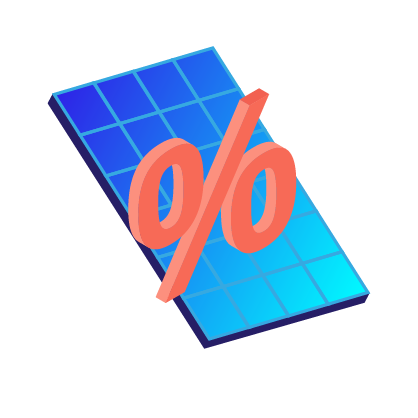Charging a Tesla Model 3 With Solar Panels vs Grid Electricity
There are plenty of reasons to drive an electric car. Near the top of the list is saving time and money by charging right at home. But is there any benefit to charging a Tesla Model 3 with solar panels instead of grid electricity?
In this article, we’ll crunch the numbers to figure out, on average, how many solar panels it takes to charge a Tesla Model 3 and how much it costs. Then, we’ll compare how much you would spend to charge a Tesla 3 with solar panels versus grid electricity.
First thing’s first: How much electricity does a Tesla Model 3 need to fully charge?
How Much Electricity Does a Tesla Model 3 Need to Charge?
There are two Tesla 3 models with different battery sizes and ranges.
- The standard 50 kWh battery with a 220-mile range
- The long-range 70 kWh battery with a 310-mile range
Let’s go with the bigger battery for our example.
According to the U.S. Department of Transportation, the average American drives 13,476 miles per year or 1,123 miles per month.
So, if you drive an average of 1,123 miles per month and the Tesla 3 with the long-range battery can drive 310 miles on a single charge, let’s find out how many full charges you’ll need per month.
1,123 miles / 310 miles per charge = 3.6 charges per month
Allowing some wiggle room for battery degradation over time and other variables, let’s put it at even 4 charges per month.
70 kWh battery x 4 charges per month = 280 kWh needed per month
To break it down by day:
280 kWh per month / 30 days in a month = 9.3 kWh needed per day
So a Tesla 3 with a 70 kWh battery requires 9.3 kWh per day for the average American driving 1,123 miles per month (~37 miles per day). Let’s see how many solar panels charging a Tesla Model 3 requires.
How many solar panels to charge a Tesla Model 3?
The amount of kWh a solar panel produces depends on the power rating of the panel and how much sun it gets. Depending on where you live in the US, that can average between 4 and 6 hours a day. We’ll split the difference and say 5 hours.
9.3 kWh per day / 5 hours of sun per day = 1.86 kW to meet energy needs
Let’s divide that by 78 percent to account for the slight loss during power conversion.
1.86 kW / .78 = 2.38 kW
Now we simply divide the kilowatts you need by the solar panel power rating to get the average number of solar panels you’ll need. Today, the most popular solar panels are rated for 400W or 0.4 kW.
2.38 kW / .4 kW = 5.95 solar panels
Rounding up, that’s roughly 6 additional 400W solar panels needed to charge the Tesla 3 with the long-range battery. Of course, the answer varies by the number of peak sun hours and the power rating of the panel.
The table below shows how many panels you need to charge a Tesla Model 3 for some common sun and panel combinations.
| Peak sun hours | Solar panel power rating | Number of panels to charge a Tesla Model 3* |
| 4 | 250W | 12 |
| 4 | 400W | 8 |
| 5 | 250W | 10 |
| 5 | 400W | 6 |
| 6 | 250W | 8 |
| 6 | 400W | 5 |
*Tesla Model 3 with 70 kWh battery with a 310-mile range driving 37 miles per day.
Now that we know how many solar panels it takes to charge a Tesla Model 3, let’s see how much each panel costs.
How Much Do Solar Panels Cost?
The average cost for residential solar panels is around $3.30 per Watt installed.
If you need 6 x 400 Watt solar panels to charge your Tesla 3, the total wattage you’ll need to charge it is 2400 Watts.
2400 W x $3.30 = $7,920
After you claim the 30% federal solar tax credit the net cost drops to $5,544.
Remember, once you have paid for those panels, they will keep on generating electricity for 25+ years. So this is the all-in cost to charge a Tesla Model 3 and the EVs that come after it for at least the next two and a half decades.
Related reading: Hyundai IONIQ 5 Charging Costs: Solar Versus Utility
Cost per kWh to charge a Tesla Model 3 with solar panels
The most useful way to break down the cost of charging a Tesla Model 3 with solar panels is by breaking it down to cents per kilowatt hour. This is the industry standard used by utilities to measure the price of electricity.
To find the cost per kWh, simply take the net cost of the system ($5,544 after the 30% tax credit in our example) and divide by the total lifetime output. In our case, a 2400W solar system with 5 hours of sun per day can be expected to produce 104,965 kWh of electricity over 25 years (assuming a 70% degradation factor).
$5,544 / 104,965 = 5.28 cents per kilowatt hour
Think of this like the price per gallon of gas. So to fully charge the Tesla Model 3’s 70 kWh battery with solar panels would cost around $3.70.
That’s right, $3.70 to travel 310 miles — and no trips to the smelly gas station! Four dollars barely buys a single gallon of gas in some places, let alone an entire tank.
How Much Would it Cost to Charge a Tesla 3 with Grid Electricity?
Now that we’ve got the cost per kWh of charging a Tesla 3 with solar panels, we can easily compare it with the cost of charging with grid electricity or public chargers.
Since many people qualify for the 30% solar tax credit, let’s use 5.28 cents per kWh. The price of grid electricity varies from place to place, but the national average is 16.7 cents per kWh at the time of writing.
Cost of charging a Tesla 3 on grid vs solar
| Charging method | Cost per kWh | Cost per full charge (70 kWh) | Cost per month (280 kWh) | Cost per year (3,360 kWh) |
| Solar panels | 5.28 cents | $3.70 | $14.78 | $177.41 |
| Grid – US average | 16.7 cents* | $11.69 | $46.76 | $561.12 |
| Grid – Chicago | 18.8 cents* | $13.16 | $52.64 | $631.68 |
| Grid – Los Angeles | 24.4 cents* | $17.08 | $68.32 | $819.84 |
| Grid – New York City | 24.5 cents* | $17.15 | $68.60 | $823.20 |
| Public charging | 40 cents | $28 | $112 | $1,344 |
Figures based on the average American driver traveling 37 miles per day. September 2022 electricity prices per BLS.
For the average American, charging a Tesla with solar panels costs $383.71 less than charging on the grid in the first year – and much more if you live in New York City, Los Angeles, or Chicago or use public chargers.
It’s also important to remember grid electricity prices rise over time, and have been rising at an average annual rate of 3.51% over the last five years.
Here’s a look at the cumulative savings of charging with solar versus grid electricity over the 25 year warrantied life of a solar system:
Pay Yourself Back by Charging Your Tesla 3 With Solar Panels
If you use solar panels to charge your Tesla 3 and apply the 30% federal solar tax credit, the payback period for your $5,544 investment is eight to nine years. By the end of 25 years you’ll have saved over $16,000 by charging with solar panels.
If you don’t have the tax liability to use the tax credit, the payback period increases to 11-12 years and the lifetime savings decrease to just under $14,000 – which is still a good chunk of change.
One way to think about charging a Tesla with solar panels is buying 25 years worth of electricity for a massive discount – in this case 5.28 c/kWh instead of 16.7 c/kWh. It takes time to recoup your investment, but the return is steady and reliable since solar panels are backed by a 25-year performance guarantee.
Connect with an Energy Advisor to see how much you could save by charging with solar.













